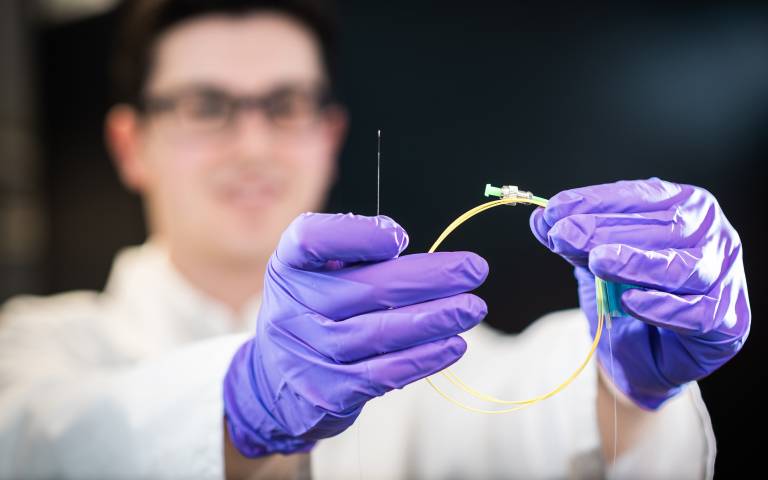First heart disease patients diagnosed using technology developed by UCL and Echopoint
14 February 2023

Researchers at University College London, in collaboration with colleagues at Barts Health NHS Trust and Queen Mary University of London, have carried out the first clinical tests of a new device to help diagnose heart disease more easily and accurately.
Heart disease is particularly common in women but is often missed due to the vagueness of symptoms and a lack of awareness relating to the condition. Having access to more accurate information on the health of a person’s heart will allow doctors to better decide what course of treatment to prescribe – medication, surgery or indeed, if the patient can stop their medication.
The new device, called iKOr, uses a fibre optic sensor and a very thin catheter to check a person’s blood pressure, look for narrowing of the arteries and can even identify problems with the smallest of heart vessels. The device has a temperature and pressure sensor that is 0.2mm wide which is threaded through the patient’s blood vessels. It measures the flow rate around the heart and detects any obstructions in the vessels.
The first clinical test in two patients, carried out at St Bartholomew’s Hospital, found that it was successful at finding problems with their “microvasculature”. These tiny blood vessels do not show up well in the angiograms typically used by cardiologists to image the heart’s larger arteries.
Medical physicists from UCL, including Professor Adrien Desjardins from UCL Medical Physics and Biomedical Engineering and the Wellcome / EPSRC Centre for Interventional and Surgical Sciences (WEISS), invented this fibre optic sensing technology and in 2019, they set up Echopoint Medical, a spinout company from UCL in partnership with Barts Health NHS Trust that has so far received around £4mn in funding and grants to carry out research and clinical testing.
Lead iKOr developer, Professor Adrien Desjardins, said: “The iKOr device is responding to a clinical need – to significantly improve how blood flow in the heart is measured.
“Our microcatheter provides concurrent pressure and flow measurements from inside coronary arteries – this is unique and makes the tiny blood vessels more measurable, compared to traditional X-rays. This will help to significantly improve diagnosis and treatment for a large group of patients; those with obstructive coronary artery disease and coronary microvascular dysfunction.
“An increasing body of evidence shows the importance of accurate assessments of the coronary microvasculature in targeting therapies, which has particular relevance to women and diabetic patients who are more likely to have microvascular dysfunction.
“In current clinical practice there is a potential for over diagnosis, resulting in invasive surgeries, such as stent insertion, that comes with risk and can take time to recover from," added Professor Desjardins.
Dr Malcom Finlay, a Consultant Cardiologist at St Bartholomew’s Hospital and Echopoint’s Chief Medical Officer said: “It’s an incredible highlight of my career to see a technology that we invented in the hospital and university being used for the first time: from bedside to bench and back!
“It shows the real, tangible benefit that collaboration between NHS hospitals and universities can have for patients my colleagues and I see day in, day out. And it’s a great example of why it’s important to carry out research in the NHS. Thank you to the patients who have agreed to be involved in this research and everyone who believed in our vision.”
This first phase of clinical testing will involve a further 8 patients and is likely to be completed by the end of May. Then, subject to regulatory approval, there will be a larger trial with 100 patients.
The iKOr device and underlying technology was developed through collaboration between University College London and Echopoint, Barts Health NHS Trust and Queen Mary University of London.
Read more
- Barts Medical NHS Trust - First tests of new device to diagnose heart disease are successful
- Financial Times - First heart patients diagnosed using new fibre optic technology
 Close
Close

